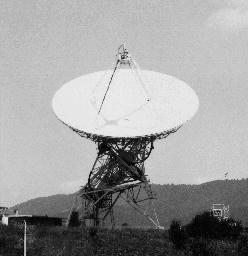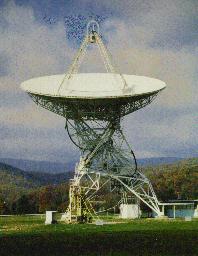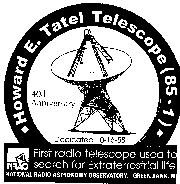The Tatel Telescope
 The Howard E. Tatel Radio Telescope, built in 1958, was
the first major radio telescope at the National Radio Astronomy Observatory
(NRAO) in Green Bank, WV. It is also known as 85-1, the first
of three 85-foot telescopes of similar design built at NRAO. Built
by the Blaw-Knox Corp. of Pittsburgh, Pa., it began regular observations
in February 1959 and did much of the pioneering radio astronomy at NRAO.
In 1964 when the NRAO decided to build an interferometer, the Tatel
Telescope became the fixed element in the NRAO
3-element interferometer system.
The Howard E. Tatel Radio Telescope, built in 1958, was
the first major radio telescope at the National Radio Astronomy Observatory
(NRAO) in Green Bank, WV. It is also known as 85-1, the first
of three 85-foot telescopes of similar design built at NRAO. Built
by the Blaw-Knox Corp. of Pittsburgh, Pa., it began regular observations
in February 1959 and did much of the pioneering radio astronomy at NRAO.
In 1964 when the NRAO decided to build an interferometer, the Tatel
Telescope became the fixed element in the NRAO
3-element interferometer system.
(click on any picture for a large version)

Technical Data
-
Reflector: 85-foot diameter paraboloid; Surface is 0.125 inch
thick aluminum panels; Surface area is 5700 square feet with better
than 0.125 inch RMS tolerance.
-
Focus: 36 feet above reflector surface and 115 feet above ground;
Carries 600 pounds of receiving equipment; position relative to paraboloid
stable to 0.25 inch.
-
Mount: Equatorial (polar and declination axis, mutually perpendicular)
-
Declination Axis: Shaft is 40 feet long, 16 inches diameter; gear is
40 feet diameter; Travel is 132 degrees total, 48 degrees north of stow and
84 degrees south of stow.
-
Polar Axis: Shaft is 23 feet long, 28 inches diameter; Gear is 48 feet
diameter; Travel is about 90 degrees either way from stow.
-
Drive Rates, Both axes: Slew is 20 degrees per minute; Scan is up to 4 degrees
per minute.
-
Material: Painted steel superstructure.
-
Brakes: Electrical set and spring set hydraulic release.
-
Total Weight: 210 tons.
-
Pointing Precision: About 30 arc seconds (about a quarter at 600 feet).
The Tatel turns 40!
The Tatel Telescope, otherwise known as "85-1" to its friends, has its 40th
birthday this year (1998).
 A commemorative T-shirt is available at the tour center
with the design pictured here.
A commemorative T-shirt is available at the tour center
with the design pictured here.
Howard E. Tatel worked for the Carnegie Institute Department of Terrestrial
Magnetism (DTM) in the 1950s and collaborated with the Blaw-Knox Company
of Pittsburgh to design a telescope for DTM. Blaw-Knox had also received
telescope orders from NRAO, the University of Michigan, and the Jet Propulsion
Laboratory. Tatel's concept used large diameter gears for the two axes to
provide high precision at relatively low cost. Bob Hall, who is now the GBT
project manager, was then manager of the antenna division at Blaw-Knox. He
expanded Tatel's concept, generated a practical working design, and supervised
the construction of these telescopes. Tatel died on a field trip in 1957
and never saw the completion of his telescopes. The NRAO 85-foot was dedicated
in October of 1958, and named in his memory. It began continuous operation
in April of 1959. Fred Crews recalls (in "The Observer" for March 31, 1964)
that the first observations were done on Friday, February 13, 1959. "Initially
there were only two operators [Fred Crews and Bill Meredith], who worked
12 hour [shifts] keeping the telescope going 24 hours a day except for week-ends
when the scientists did their own observing."
Although best-known as the telescope used by Frank Drake for the first
search for extraterrestrial intelligence,
Project Ozma,
most of its time was spent in basic exploration of the radio universe. Surveys
of radio sources provided accurate positions and flux densities at several
frequencies. Surface temperatures were measured for Venus and the Moon. Studies
were done of Jupiter's radiation belts. The structure and composition of
the galaxy and regions near the galactic center were studied for the first
time.
In the mid 1960s, two more 85-foot telescopes were built to the same design
to become the three-element Green Bank Interferometer (GBI). This was used
for studying fine structure in radio objects. The GBI did the first radio
measurement that confirmed to high accuracy the prediction by general relativity
of the bending of light (i.e. any electromagnetic radiation) near a massive
body. The GBI was the prototype instrument for the VLA. From 1978 to 1994
the GBI was operated by the USNO for studies of Earth rotation and monitoring
of variable sources. Today the Tatel Telescope is still in continuous use
as part of the GBI, now funded partly by NASA for studies of x-ray and gamma-ray
sources.
Fred Crews concludes, in the 1964 Observer article, "The 85' Tatel telescope
has now been in operation for 5 years. Its life expectancy is 20 years."
Today the telescope has been productive for twice its expected lifetime,
thanks to Howard Tatel's initiative, and is still in good working order.
How many of us can say the same?
[Compiled and edited by F. Ghigo, NRAO-Green Bank, WV. February 1999]
last modified: June 2000.
 The Howard E. Tatel Radio Telescope, built in 1958, was
the first major radio telescope at the National Radio Astronomy Observatory
(NRAO) in Green Bank, WV. It is also known as 85-1, the first
of three 85-foot telescopes of similar design built at NRAO. Built
by the Blaw-Knox Corp. of Pittsburgh, Pa., it began regular observations
in February 1959 and did much of the pioneering radio astronomy at NRAO.
In 1964 when the NRAO decided to build an interferometer, the Tatel
Telescope became the fixed element in the NRAO
3-element interferometer system.
The Howard E. Tatel Radio Telescope, built in 1958, was
the first major radio telescope at the National Radio Astronomy Observatory
(NRAO) in Green Bank, WV. It is also known as 85-1, the first
of three 85-foot telescopes of similar design built at NRAO. Built
by the Blaw-Knox Corp. of Pittsburgh, Pa., it began regular observations
in February 1959 and did much of the pioneering radio astronomy at NRAO.
In 1964 when the NRAO decided to build an interferometer, the Tatel
Telescope became the fixed element in the NRAO
3-element interferometer system.

